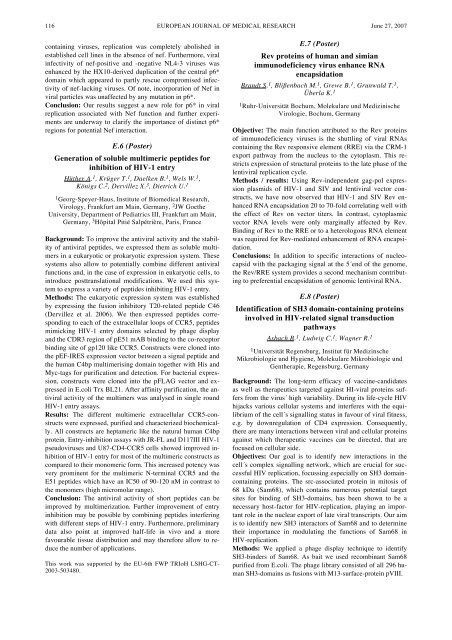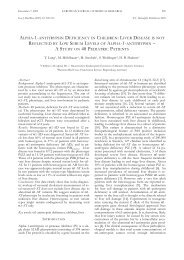European Journal of Medical Research - Deutsche AIDS ...
European Journal of Medical Research - Deutsche AIDS ...
European Journal of Medical Research - Deutsche AIDS ...
Create successful ePaper yourself
Turn your PDF publications into a flip-book with our unique Google optimized e-Paper software.
116 EUROPEAN JOURNAL OF MEDICAL RESEARCH<br />
June 27, 2007<br />
containing viruses, replication was completely abolished in<br />
established cell lines in the absence <strong>of</strong> nef. Furthermore, viral<br />
infectivity <strong>of</strong> nef-positive and -negative NL4-3 viruses was<br />
enhanced by the HX10-derived duplication <strong>of</strong> the central p6*<br />
domain which appeared to partly rescue compromised infectivity<br />
<strong>of</strong> nef-lacking viruses. Of note, incorporation <strong>of</strong> Nef in<br />
viral particles was unaffected by any mutation in p6*.<br />
Conclusion: Our results suggest a new role for p6* in viral<br />
replication associated with Nef function and further experiments<br />
are underway to clarify the importance <strong>of</strong> distinct p6*<br />
regions for potential Nef interaction.<br />
E.6 (Poster)<br />
Generation <strong>of</strong> soluble multimeric peptides for<br />
inhibition <strong>of</strong> HIV-1 entry<br />
Hüther A. 1 , Krüger T. 1 , Daelken B. 1 , Wels W. 1 ,<br />
Königs C. 2 , Dervillez X. 3 , Dietrich U. 1<br />
1 Georg-Speyer-Haus, Institute <strong>of</strong> Biomedical <strong>Research</strong>,<br />
Virology, Frankfurt am Main, Germany, 2 JW Goethe<br />
University, Department <strong>of</strong> Pediatrics III, Frankfurt am Main,<br />
Germany, 3 Hôpital Pitié Salpétrière, Paris, France<br />
Background: To improve the antiviral activity and the stability<br />
<strong>of</strong> antiviral peptides, we expressed them as soluble multimers<br />
in a eukaryotic or prokaryotic expression system. These<br />
systems also allow to potentially combine different antiviral<br />
functions and, in the case <strong>of</strong> expression in eukaryotic cells, to<br />
introduce posttranslational modifications. We used this system<br />
to express a variety <strong>of</strong> peptides inhibiting HIV-1 entry.<br />
Methods: The eukaryotic expression system was established<br />
by expressing the fusion inhibitory T20-related peptide C46<br />
(Dervillez et al. 2006). We then expressed peptides corresponding<br />
to each <strong>of</strong> the extracellular loops <strong>of</strong> CCR5, peptides<br />
mimicking HIV-1 entry domains selected by phage display<br />
and the CDR3 region <strong>of</strong> pE51 mAB binding to the co-receptor<br />
binding site <strong>of</strong> gp120 like CCR5. Constructs were cloned into<br />
the pEF-IRES expression vector between a signal peptide and<br />
the human C4bp multimerising domain together with His and<br />
Myc-tags for purification and detection. For bacterial expression,<br />
constructs were cloned into the pFLAG vector and expressed<br />
in E.coli Trx BL21. After affinity purification, the antiviral<br />
activity <strong>of</strong> the multimers was analysed in single round<br />
HIV-1 entry assays.<br />
Results: The different multimeric extracellular CCR5-constructs<br />
were expressed, purified and characterized biochemically.<br />
All constructs are heptameric like the natural human C4bp<br />
protein. Entry-inhibition assays with JR-FL and D117III HIV-1<br />
pseudoviruses and U87-CD4-CCR5 cells showed improved inhibition<br />
<strong>of</strong> HIV-1 entry for most <strong>of</strong> the multimeric constructs as<br />
compared to their monomeric form. This increased potency was<br />
very prominent for the multimeric N-terminal CCR5 and the<br />
E51 peptides which have an IC50 <strong>of</strong> 90-120 nM in contrast to<br />
the monomers (high micromolar range).<br />
Conclusion: The antiviral activity <strong>of</strong> short peptides can be<br />
improved by multimerization. Further improvement <strong>of</strong> entry<br />
inhibition may be possible by combining peptides interfering<br />
with different steps <strong>of</strong> HIV-1 entry. Furthermore, preliminary<br />
data also point at improved half-life in vivo and a more<br />
favourable tissue distribution and may therefore allow to reduce<br />
the number <strong>of</strong> applications.<br />
This work was supported by the EU-6th FWP TRIoH LSHG-CT-<br />
2003-503480.<br />
E.7 (Poster)<br />
Rev proteins <strong>of</strong> human and simian<br />
immunodeficiency virus enhance RNA<br />
encapsidation<br />
Brandt S. 1 , Blißenbach M. 1 , Grewe B. 1 , Grunwald T. 1 ,<br />
Überla K. 1<br />
1 Ruhr-Universität Bochum, Molekulare und Medizinische<br />
Virologie, Bochum, Germany<br />
Objective: The main function attributed to the Rev proteins<br />
<strong>of</strong> immunodeficiency viruses is the shuttling <strong>of</strong> viral RNAs<br />
containing the Rev responsive element (RRE) via the CRM-1<br />
export pathway from the nucleus to the cytoplasm. This restricts<br />
expression <strong>of</strong> structural proteins to the late phase <strong>of</strong> the<br />
lentiviral replication cycle.<br />
Methods / results: Using Rev-independent gag-pol expression<br />
plasmids <strong>of</strong> HIV-1 and SIV and lentiviral vector constructs,<br />
we have now observed that HIV-1 and SIV Rev enhanced<br />
RNA encapsidation 20 to 70-fold correlating well with<br />
the effect <strong>of</strong> Rev on vector titers. In contrast, cytoplasmic<br />
vector RNA levels were only marginally affected by Rev.<br />
Binding <strong>of</strong> Rev to the RRE or to a heterologous RNA element<br />
was required for Rev-mediated enhancement <strong>of</strong> RNA encapsidation.<br />
Conclusions: In addition to specific interactions <strong>of</strong> nucleocapsid<br />
with the packaging signal at the 5´end <strong>of</strong> the genome,<br />
the Rev/RRE system provides a second mechanism contributing<br />
to preferential encapsidation <strong>of</strong> genomic lentiviral RNA.<br />
E.8 (Poster)<br />
Identification <strong>of</strong> SH3 domain-containing proteins<br />
involved in HIV-related signal transduction<br />
pathways<br />
Asbach B. 1 , Ludwig C. 1 , Wagner R. 1<br />
1 Universität Regensburg, Institut für Medizinsche<br />
Mikrobiologie und Hygiene, Molekulare Mikrobiologie und<br />
Gentherapie, Regensburg, Germany<br />
Background: The long-term efficacy <strong>of</strong> vaccine-candidates<br />
as well as therapeutics targeted against HI-viral proteins suffers<br />
from the virus´ high variability. During its life-cycle HIV<br />
hijacks various cellular systems and interferes with the equilibrium<br />
<strong>of</strong> the cell´s signalling status in favour <strong>of</strong> viral fitness,<br />
e.g. by downregulation <strong>of</strong> CD4 expression. Consequently,<br />
there are many interactions between viral and cellular proteins<br />
against which therapeutic vaccines can be directed, that are<br />
focused on cellular side.<br />
Objectives: Our goal is to identify new interactions in the<br />
cell´s complex signalling network, which are crucial for successful<br />
HIV replication, focussing especially on SH3 domaincontaining<br />
proteins. The src-associated protein in mitosis <strong>of</strong><br />
68 kDa (Sam68), which contains numerous potential target<br />
sites for binding <strong>of</strong> SH3-domains, has been shown to be a<br />
necessary host-factor for HIV-replication, playing an important<br />
role in the nuclear export <strong>of</strong> late viral transcripts. Our aim<br />
is to identify new SH3 interactors <strong>of</strong> Sam68 and to determine<br />
their importance in modulating the functions <strong>of</strong> Sam68 in<br />
HIV-replication.<br />
Methods: We applied a phage display technique to identify<br />
SH3-binders <strong>of</strong> Sam68. As bait we used recombinant Sam68<br />
purified from E.coli. The phage library consisted <strong>of</strong> all 296 human<br />
SH3-domains as fusions with M13-surface-protein pVIII.





